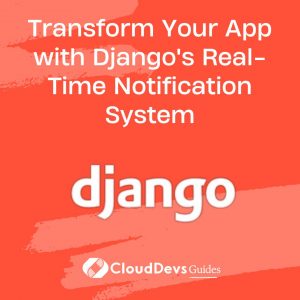Transform Your App with Django’s Real-Time Notification System
In the fast-paced digital world, where information is constantly changing, real-time notifications have become an essential feature for web applications. Django, a high-level Python web framework, provides an excellent platform for developers to implement these features. This article explores how to keep users updated instantly with real-time notifications using Django. You can hire Django Developers for your projects to ensure greater success.
Table of Contents
1. Understanding Real-Time Notifications
Real-time notifications are immediate alerts sent to users to inform them of new messages, updates, or other interactions. Unlike traditional notifications that require a page refresh to display new information, real-time notifications appear instantly as events occur.
2. Importance in Modern Web Applications
- User Engagement: Keeps users engaged with up-to-the-minute updates.
- Improved User Experience: Provides a seamless, interactive user experience.
- Timely Information: Critical for applications where immediate information delivery is crucial, such as in financial trading platforms or social media sites.
3. Django’s Role in Real-Time Notifications
Django, being a versatile web framework, supports the integration of real-time notification systems. It offers various tools and packages that can be used to build these systems efficiently.
3.1. Django Channels
Django Channels extends Django to handle WebSockets, crucial for real-time notifications. It allows Django to manage long-lived connections, which are essential for pushing notifications to users instantly.
Read more: Django Channels Documentation
Key Features:
– Asynchronous Support: Enables handling of many simultaneous connections.
– WebSockets Protocol: Provides a two-way interactive communication session.
3.2. Django Notifications
Another tool, `django-notifications`, is a GitHub project providing Django apps with a notification system. It offers a simple model to store and display notifications to users.
4. Implementing Real-Time Notifications in Django
4.1. Step-by-Step Guide
- Setting Up Django Channels:
– Install Django Channels.
– Add it to your Django project’s settings.
– Configure a routing file for WebSocket connections.
- Creating Notification Models:
– Define a model to store notification data.
– Implement signal receivers to trigger notifications on certain actions.
- WebSocket Consumers:
– Create WebSocket consumers to handle the sending and receiving of messages.
Read more:Using WebSockets with Django
- Frontend Integration:
– Use JavaScript to establish WebSocket connections and update the UI in real-time.
Example:
Imagine a social media application where users receive notifications for new messages or likes.
– Backend Setup: Using Django Channels, set up WebSocket routes and consumers.
– Notification Trigger: When a user likes a post, a signal is sent to create a notification.
– WebSocket Consumer: Handles this signal and sends a notification to the relevant user’s WebSocket.
– Frontend: JavaScript listens for these WebSocket messages and updates the notification icon/count instantly.
Read more: Django Real-Time Notifications
5. Challenges and Best Practices
– Scalability: Ensure the system can handle a high number of concurrent connections.
– Security: Implement secure WebSocket connections and validate all incoming data.
– Testing: Regularly test notification systems to ensure reliability.
Conclusion
Real-time notifications are a dynamic feature that can significantly enhance user experience. Django, with its robust framework and supporting libraries like Django Channels, provides a solid foundation for integrating these notifications. By following best practices and staying aware of challenges, developers can implement effective real-time notification systems that keep users engaged and informed.
You can check out our other blog posts to learn more about Django. We bring you a complete guide titled Django Real-time Alerts: A Push Notification Guide along with the Master Real-Time Communication in Django Apps with WebSockets and The Essential Guide to Social Logins in Django with OAuth and OpenID which will help you understand and gain more insight into the Django programming language.
Table of Contents







